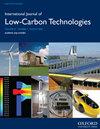Performance evaluation of marine and industrial wastes in cement to envelope low carbon environment in manufacturing process
IF 2.3
4区 工程技术
Q3 ENERGY & FUELS
引用次数: 0
Abstract
The bonding strength of waste recycled cement mortar in a low carbon brick masonry prism is influenced by this study. The disposal of marine and industrial trash has emerged as a serious environmental and ecological concern across the world against the climate action of the United Nations Sustainable Development Goals (UNSDGs) and COP27. The use of alternative waste materials in the cement industry minimizes the carbon footprint in the manufacture, construction and overall building lifespan and enhances low carbon technology. The bonding 1ehaveior of the 3R hybrid cement (oyster shell, ground granulated blast furnace slag and tyre waste powder) is evaluated in a brick masonry prism. The impact of hybrid mortar bond strength on triplet masonry prism specimens and cement mortar cubes is investigated in this study using first-class bricks and OPC 53 cement with 3R waste materials. In addition, the chemical characteristics, workability, compressive strength, shear, bond, thermal, durable and microstructure studies of traditional and hybrid cement composites were determined. These three waste material compositions in the cement matrix have an influence on the development of alternative waste recycling and reuse materials in industry. Using hybrid cement saves CO2 emissions, low carbon emissions and energy consumption and has economic and environmental implications. The testing findings show that the brick-and-mortar bond has an excellent lead with the maximum compressive strength of the brick masonry prism.海洋废弃物与工业废弃物在水泥制造过程中围护低碳环境的性能评价
研究了废再生水泥砂浆在低碳砖砌体棱镜中的粘结强度。在联合国可持续发展目标(UNSDGs)和COP27的气候行动背景下,海洋和工业垃圾的处理已成为全球严重的环境和生态问题。在水泥行业中使用替代废料可以最大限度地减少制造、施工和整体建筑寿命中的碳足迹,并提高低碳技术。在砖砌体棱镜中对牡蛎壳、磨碎的高炉矿渣和轮胎废粉等3R混合水泥的粘结性能进行了评价。本研究采用一级砖和opc53水泥加3R废料,研究了混合砂浆粘结强度对三元砌体棱柱试件和水泥砂浆立方体的影响。此外,对传统和混合水泥复合材料的化学特性、和易性、抗压强度、抗剪强度、粘结性、热性能、耐久性和微观结构进行了研究。水泥基体中这三种废弃物成分对工业上替代废弃物回收再利用材料的发展产生了影响。使用混合水泥可以减少二氧化碳排放,降低碳排放和能源消耗,并具有经济和环境意义。试验结果表明,砖石结合层具有良好的引导性,具有砖砌体最大抗压强度。
本文章由计算机程序翻译,如有差异,请以英文原文为准。
求助全文
约1分钟内获得全文
求助全文
来源期刊

International Journal of Low-carbon Technologies
Engineering-Architecture
CiteScore
4.30
自引率
4.30%
发文量
106
审稿时长
27 weeks
期刊介绍:
The International Journal of Low-Carbon Technologies is a quarterly publication concerned with the challenge of climate change and its effects on the built environment and sustainability. The Journal publishes original, quality research papers on issues of climate change, sustainable development and the built environment related to architecture, building services engineering, civil engineering, building engineering, urban design and other disciplines. It features in-depth articles, technical notes, review papers, book reviews and special issues devoted to international conferences. The journal encourages submissions related to interdisciplinary research in the built environment. The journal is available in paper and electronic formats. All articles are peer-reviewed by leading experts in the field.
 求助内容:
求助内容: 应助结果提醒方式:
应助结果提醒方式:


